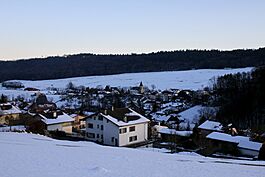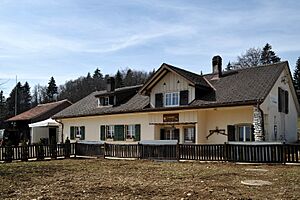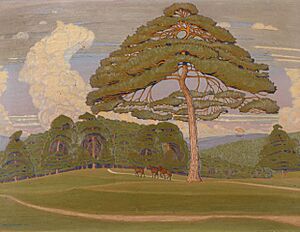Orvin facts for kids
Quick facts for kids
Orvin
|
||
|---|---|---|

Orvin village
|
||
|
||
| Country | Switzerland | |
| Canton | Bern | |
| District | Jura bernois | |
| Area | ||
| • Total | 21.59 km2 (8.34 sq mi) | |
| Elevation | 669 m (2,195 ft) | |
| Population
(Dec 2020 )
|
||
| • Total | 1,198 | |
| • Density | 55.49/km2 (143.71/sq mi) | |
| Demonym(s) | Orvinois | |
| Postal code |
2534
|
|
| Localities | Jorat, Les Prés-d'Orvin | |
| Surrounded by | Corgémont, Sonceboz-Sombeval, La Heutte, Péry, Vauffelin, Biel/Bienne, Evilard, Lamboing, Nods | |
Orvin is a small town, also called a municipality, in Switzerland. It is located in the canton of Bern, which is like a state. Orvin is in the French-speaking part of the Bernese Jura mountains. Above the town, there is a small, year-round resort called Les Prés-d'Orvin.
Contents
History of Orvin
Orvin was first mentioned in old records in the year 866. Back then, it was called Ulvinc.
Around the year 999, a king named Rudolph III of Burgundy gave Orvin to the Prince-Bishop of Basel. The village stayed under the Bishop's control for a long time. Later, in 1295, the Lords of Orvin were given the village to manage. They kept it until the late 1300s. After that, it was controlled by other families, like the d'Orsans and the Lords of Rondchâtel.
Eventually, Orvin returned to the Bishop's control. The Bishop then placed it under the care of Biel. Orvin received its first set of rules, called a town charter, in 1352. These rules were updated in 1643 and confirmed in 1668. They stayed in place until the end of the old system of government.
Starting in the 1300s, the people of Orvin who had to serve in the army were part of a group from Erguel. This group was controlled by Biel. However, from 1649 to 1852, they had their own separate military group with its own flag. This military group became very important locally. It even became rich by lending money to others.
Changes to the Village Church
The old village church was called St. Peter. It was part of the diocese of Lausanne, even though the town belonged to the Bishop of Basel. The original St. Peter's church was eventually taken down. A new church, built in the Gothic style, was constructed in a different spot. That Gothic church was also demolished in 1722. The church you see today was built in its place. It is in the Baroque style and was decorated in 1916 by an artist named Paul Robert.
In 1530, the village decided to become Protestant, following the Protestant Reformation.
Modern Times
In 1797, France won a war, and Orvin became part of France. It was first part of the Mont-Terrible region, then the Haut-Rhin region in 1800. After Napoleon lost power, Orvin was given to the Canton of Bern in Switzerland. This happened at a big meeting called the Congress of Vienna.
In the late 1800s, Orvin was quite isolated. It wasn't connected to the growing Swiss railroad network. Most people worked in farming. In 1930, there were 95 farms in the area.
However, in the 1950s, things started to change. Better roads were built, and more people began to move to Orvin. Over the next 20 years, the population grew by almost a third! As the town grew, several factories opened. The first one, the Schäublin factory, opened in 1954. Other companies like Bulova, Léchot, LNS, and Precimed also opened factories. By 2005, only 10% of the people worked in farming. Most people worked in factories.
The resort village of Les Prés-d'Orvin also grew quickly. Many people from nearby cities like Biel and Solothurn bought chalets there. In 1951, Les Prés-d'Orvin had 181 houses. By 1975, this number had grown to 332.
Geography of Orvin
Orvin covers an area of about 21.43 square kilometers (8.27 square miles). A large part of this land, about 37.6%, is used for farming. Even more, about 57.2%, is covered by forests. The rest of the land is used for buildings and roads, or it's unproductive land.
Orvin is located north of the city of Biel/Bienne. It sits in a side valley of the Suze river.
On January 1, 2010, Orvin became part of a new administrative district called Arrondissement administratif Jura bernois.
Orvin's Coat of Arms
The blazon (description) of Orvin's coat of arms is: A yellow shield with a green base. On the base, there is a peasant (farmer) dressed in red. He is fighting a black bear that is standing on its hind legs. The bear has a red tongue and claws. The peasant is holding a black spear with a silver tip.
People of Orvin (Demographics)
Orvin has a population of about 1,200 people. As of 2010, about 9.1% of the people living in Orvin were foreign nationals. Over the last ten years (2000-2010), the population changed by about -4%. This means it got a little smaller. More people moved into Orvin than moved out, but more people died than were born.
Most people in Orvin speak French as their main language (about 82.5%). German is the second most common language (about 14.2%), followed by Albanian.
In 2008, about 50.5% of the population was male and 49.5% was female. Most people in Orvin were born in Switzerland. About 37.5% were born right in Orvin.
As of 2010, children and teenagers (ages 0–19) make up about 21.7% of the population. Adults (ages 20–64) make up 58.2%, and seniors (over 64) make up 20.1%.
Many people in Orvin are married. In 2000, there were 593 married people. There were also 479 single people.
The chart below shows how Orvin's population has changed over time:

Cool Places to See
The entire village of Orvin is considered an important Swiss heritage site. This means it's a special place with historical or cultural value. The nearby Taubenloch canyon is also part of this heritage site.
Economy and Jobs
In 2011, Orvin had a low unemployment rate of 1.24%. This means most people who wanted jobs had them. In 2008, there were 557 people working in the municipality.
Jobs in Orvin are divided into three main types:
- Primary sector: This includes jobs like farming and forestry. About 48 people worked in this area.
- Secondary sector: This includes jobs in factories and construction. About 333 people worked here.
- Tertiary sector: This includes jobs in services, like shops, restaurants, healthcare, and education. About 176 people worked in this sector.
Many people who live in Orvin travel to other towns for work. In 2000, 336 people left Orvin to work elsewhere, while 210 people came into Orvin for work. Most people (57.9%) used a private car to get to work, while 10.6% used public transportation.
Religion in Orvin
Based on a census from 2000, about 13.4% of the people in Orvin were Roman Catholic. A larger group, about 62.6%, belonged to the Swiss Reformed Church (a Protestant church). There were also smaller numbers of people who belonged to other Christian churches, or were Islamic. About 8.66% of the population said they didn't belong to any church, or were agnostic or atheist.
Education in Orvin
In Orvin, about 36.3% of the people have finished upper secondary education. This is like high school. About 9.5% have gone on to higher education, like university.
The school system in the Canton of Bern works like this:
- One year of non-required Kindergarten.
- Six years of Primary school.
- Three years of required lower Secondary school. Here, students are grouped by their abilities.
After lower Secondary school, students can continue their education or start an apprenticeship (learning a trade).
During the 2010–11 school year, 116 students attended classes in Orvin. There was one kindergarten class with 23 students. There were five primary classes with 93 students.
In 2000, 27 students came to Orvin to attend school. At the same time, 80 students from Orvin went to schools in other towns.
See also
 In Spanish: Orvin para niños
In Spanish: Orvin para niños







